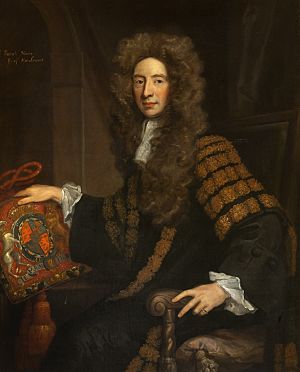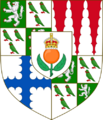Patrick Hume, 1st Earl of Marchmont facts for kids
Quick facts for kids
The Earl of Marchmont
|
|
|---|---|

Portrait by Godfrey Kneller.
|
|
| Lord Chancellor of Scotland | |
| In office 1696–1702 |
|
| Monarch | William II |
| Preceded by | The Marquess of Tweeddale |
| Succeeded by | The Earl of Seafield |
| Personal details | |
| Born | 13 January 1641 Polwarth, Berwickshire, Scotland |
| Died | 2 August 1724 (aged 83) Berwick-on-Tweed, Great Britain |
| Resting place | Canongate Kirkyard, Edinburgh |
| Spouse | Grizel Ker |
| Children | 4 sons 5 daughters |
| Alma mater | University of Paris |
| Military service | |
| Battles/wars | Argyll's Rising Glorious Revolution |
Patrick Hume, 1st Earl of Marchmont (born January 13, 1641 – died August 2, 1724) was an important Scottish politician. He was known by different names during his life, including Sir Patrick Hume and Lord Polwarth. His family had a history of serving in important roles.
Contents
A Young Politician's Life
Patrick Hume was born in a place called Polwarth in Scotland. He grew up in a very religious family, following the Presbyterian faith. After studying law in Paris, France, he became a member of the Scottish parliament in 1665. He represented the area of Berwickshire.
In parliament, he quickly became a strong supporter of the Covenanters. These were people who wanted to protect the Presbyterian Church in Scotland. His strong beliefs even led to him being put in prison for a while.
Escape and Return
After being freed, Patrick Hume was suspected of being involved in a plot against the King. This plot was called the Rye House Plot. To stay safe, he had to hide and then escape to the Netherlands in disguise.
While in the Netherlands, he joined a group led by Archibald Campbell, 9th Earl of Argyll. They tried to lead an uprising in Scotland in 1685, but it failed. Patrick Hume became a wanted man, but he managed to escape again. He lived in a city called Utrecht and pretended to be a Scottish surgeon named "Dr. Wallace."
He returned to Scotland in 1688 with William of Orange during an event known as the Glorious Revolution. This revolution changed who was king and queen of England and Scotland. After returning, Patrick Hume rejoined the Scottish parliament. In 1690, he was given the title of Lord Polwarth.
Becoming a Lord Chancellor
Patrick Hume's family lands were given back to him. He became a Scottish peer, which meant he had a special high rank in society. In 1696, he was made Lord Chancellor of Scotland. This was a very powerful position, like being the chief judge and head of the government.
In 1697, he received an even higher title: Earl of Marchmont. However, when Queen Anne became ruler in 1702, he lost his job as Lord Chancellor.
Later Political Life
Patrick Hume strongly disagreed with the idea of the "Old Pretender" becoming king. The "Old Pretender" was the son of the previous king, who had been removed during the Glorious Revolution. Patrick Hume also voted for Scotland to join with England, forming the Kingdom of Great Britain. This was a very big decision for Scotland.
He did not hold many important jobs in Great Britain until George I became king. He had some smaller roles but soon retired from politics. Patrick Hume was also an active freemason, which is a member of a social and charitable organization.
Family Life
Patrick Hume had a large family. Sadly, at least six of his children died when they were very young. They were buried in a place called Greyfriars Kirkyard.
One of his sons, Sir Andrew Hume, also became a politician.
His oldest daughter, Grisell Hume, was quite famous. She wrote a popular song in the 17th century called "Werna my Heart Licht I Wad Dee" (which means "Were not My Heart Light I would Die"). Another daughter, Julian, married an English soldier.
Images for kids



